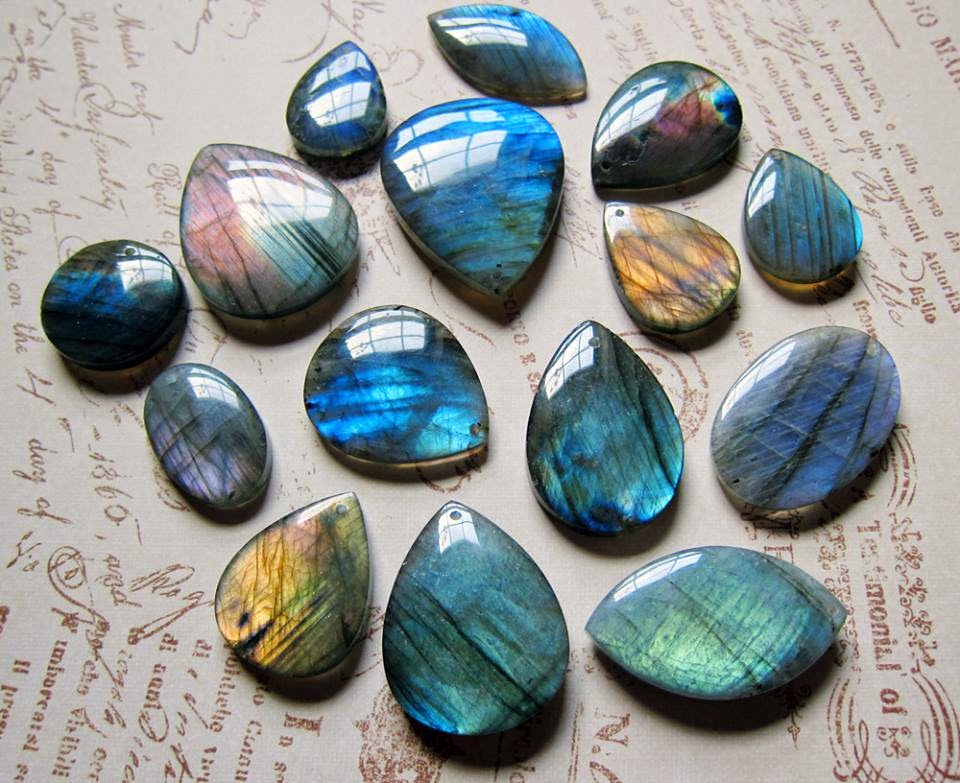 |
| Labradorite rough from Madagascar. Ready for cutting and polishing. |
Labradorite is a member of the Feldspar family of rocks, and is a mix of calcium, sodium, aluminum, silicon and others. It is found in magma-born rocks like basalt. The stone is generally a semi-translucent base of grayish rock. Its luster, called labradorescence, occurs because the metallic elements did not fuse while cooling; instead they coexist closely together and produce a light diffraction effect colored with beautiful shades of light blues, greens and yellows. Labradorite is almost exclusively found in the northeastern province of subarctic Labrador, Canada. Some other varieties have been found in Madagascar, and Spectrolite is a very dark Labradorite with more color play from Finland. Rarer purple Labradorite also exists, with a shine that plays up orange, lavender and blue hues. Labradorite has been called Black Moonstone, and while it and Moonstone are of the Feldspar family, Moonstone has a white base and contains potassium instead of calcium.
 |
| Labradorite stones, cut and polished. |
Labradorite has a hardness of 6 to 6.5 on the Mohs scale. It can be sliced, carved and polished. It is a newer stone in jewelry making history, it was discovered and introduced to Europe in the late 1700s. The native people of northern Canada, called the Inuit, used the “firestone” as medicine or offerings. They tell several legends of the “firestone” origin, but one striking story is that of an Inuit warrior who roamed the Labrador coasts. He found the Northern Lights trapped in the rocks, and with a mighty strike of his spear, he freed many of the Lights. However, some remained enclosed in the stone and became Labradorite.
 |
Labradorite cabs, cut and polished, ready for use. Notice the vast range
of colors, like rust, lavender, sky blue, moss green and yellow.
|
This stone has been used for centuries in jewelry, and is still in use today. It is well loved for its color play, but care must be taken when cutting and polishing it because of its many layers (the source of its shine). Many artisans use it in earring and necklace designs to help preserve it during wear, but larger, unfaceted forms can be used in bracelets and rings. Labradorite continues to be a staple for jewelry artisans everywhere!


Above and below is a collection of contemporary jewelry made with common and rare Labradorite stones. Above left is a sterling silver and Labradorite pendant named Truly Elvish, made by ElnaraNiall. Below left are mixed-metal earrings with Labradorite created by Sky & Beyond. On right is a sterling and Labradorite necklace designed by Mirinda Kossoff.
Below left shows a purple Labradorite ring made with sterling silver by Ashley Spatula. On right is a Spectrolite, sterling silver, tanzanite and pink sapphire in a hand-fabricated pendant by Different Seasons Jewelry. Notice the greater and more intense range of colors and nearly black base.
Also see our website at www.drygulch.com to see our collection of Labradorite bead strands!





No comments:
Post a Comment
Note: Only a member of this blog may post a comment.